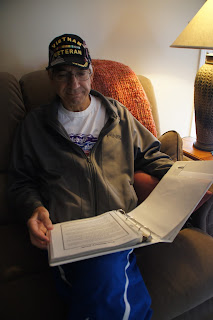 |
| Tom looking over his scrapbook that contains memories of the Viet Nam War. |
Tuesday, June 23, 2015
The "The Horrors of Battle: Part I"
It was an ordinary day. Watching a DVD of my friend and neighbor, Tom, which shows him talking to a class of sophomore high school students about the Viet Nam War. They sit with eyes opened wide, staring at Tom as he talks of having to pull his poncho over his head to avoid getting covered with Agent Orange that is dropping from the skies, during the middle of the night, by the U.S. airplanes. It was in early April of 1968 that he arrived in Vietnam, a 127,207 square mile country located in Southeast Asia, to try and help the South Vietnamese people fight off the people to the north. Tom was one of the sentries that patrolled with his loyal dog "Lucky" during the night, guarding his platoon and keeping a watch for the North Vietnamese troops. He eventually saw field duty and it was during that time that he got to witness the horrors of the chemical known today as Agent Orange. The chemical was used by the U.S. military as part of its herbicidal warfare program in Vietnam to help defoliate the landscape and make it easier to see the enemy. Agent Orange was manufactured primarily by Monsanto and Dow and was given the name from the color of the orange-striped barrels in which it was shipped. The oil-based liquid was dropped mainly at night while the US troops slept. Tom, during a visit with him, told me that while bedded down in their camps, would hear the planes arriving to dump the liquid and would have to pull their ponchos over themselves to avoid getting covered with the liquid. The next morning they would hike to nearby streams to wash the liquid from their ponchos and witness residents of South Vietnam washing their clothes and dishes in the stream that had just been covered with the orange-smelling liquid the night before.
The residents also gathered containers of water to take to their homes to drink and bath in. Agent Orange would kill the animals and people, sometimes within a week of being covered with the chemical. After returning home after the war, many servicemen faced the fact that they were probably going to develop prostrate cancer from the Agent Orange contamination. Reports from the early 2000's showed that over 52,000 men had been reported to have prostrate cancer from the chemical, including Tom. How many more may have it or have died from it is unknown. The chemical can be in your body for up to 35 years or more before it begins to create problems. And if you have the chemical in your body, it never leaves. Tom, at present is a three-time cancer surviver, all due to Agent Orange. He fought the prostrate problem, then developed thyroid cancer which had to be surgically removed and now is fighting cancer in his spine. His time from June of 1968 to July of 1969 spent in Vietnam, and being exposed many times to Agent Orange, has been a living nightmare for him. His cancer is being controlled at present without surgery, but he worries about what will happen next. One of the worst parts of the use of Agent Orange during the Vietnam War is that it may have helped find the enemy, but was it worth all the pain and suffering it caused the residents of South Vietnam or the many American heroes that fought valiantly for years in a country that was overrun with the enemy immediately after we pulled our troops from battle. And, after returning home, many were persecuted for being part of the war in Vietnam. Tomorrow I will feature a few of Tom's photos from his scrapbook of memories from the war in Vietnam. It was another extraordinary day in the life of an ordinary guy.

No comments:
Post a Comment